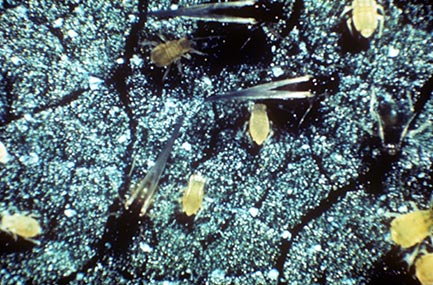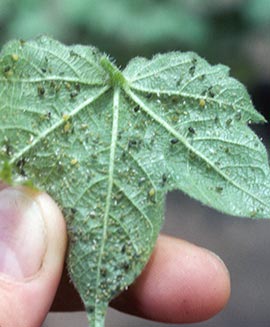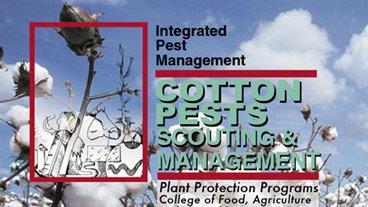 Aphids live on all plants, including cotton. Aphids do not suck the sap out of leaves; they just stick their little piercing-sucking mouthpart into a leaf and let the normal flow of plant sap force-feed them. Each aphid has three nozzles on the butt end. Two are higher up on the terminal abdomen on each side, with a lower one in the middle. The aphid needs three orifices to get rid of all the excess sap it cannot digest.
Aphids live on all plants, including cotton. Aphids do not suck the sap out of leaves; they just stick their little piercing-sucking mouthpart into a leaf and let the normal flow of plant sap force-feed them. Each aphid has three nozzles on the butt end. Two are higher up on the terminal abdomen on each side, with a lower one in the middle. The aphid needs three orifices to get rid of all the excess sap it cannot digest.
Aphids fly into fields as winged adults. They overwinter as eggs. When the spring eggs hatch, they are all female. These females give birth to live young — five to 10 a day — within a week of birth. Aphid females are born pregnant and produce more females in a process called parthenogenesis. When the weather cools, aphids produce males and females that mate to produce the overwintering eggs that restart the cycle.

Aphids on a cotton leaf
Left unchecked, aphids will completely cover every leaf on a cotton plant and produce a sticky syrup called honeydew. Aphids in cotton can cause fruit to abort on the nodes they occupy.
To determine the use of control methods with aphids, look for beneficial insects. Aphids are on the menu for most insect predators. If beneficial insects are present, they will control them quickly.
If not, other control measures are necessary. Some foliar systemic insecticides control aphids very well.
Still, remember that most insect predator and parasite populations that control other crop pests later in the season use aphids to grow. So let the beneficials control aphids if they are present. Save your other control methods for later, when the beneficial insects are overwhelmed with other pests, like plant bugs.
